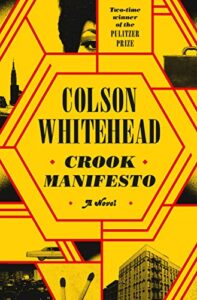Fiction. 336 pgs. Double Day Books. July 2023. 9780385545150.
Long a staple of genre fiction, sequels and series have never held much favor in the blue-ribbon literary scene. Because “works of literature” are often years-long undertakings, authors favor reinvention instead of reprise. Thus, with each creation, a fresh mound of clay. Another chance to get it right.
Artistic growth is certainly easier to measure outside of a series than within one. But continuity comes with its own assets, and when you’ve already summited the literary crag—twice, for that matter—transformation can take a hike. With his new novel Crook Manifesto, two-time Pulitzer winner Colson Whitehead delivers not just a sequel to 2021’s Harlem Shuffle but a sequel in its most archetypal configuration, thrusting readers back into the unapologetically complicated life of furniture salesman and occasional jewelry fence Ray Carney.
An honorable outlaw, a self-made Black entrepreneur, and a Harlem lifer, Carney straddles the margins of nearly every social circle in Black New York and some in white New York as well, making him an ideal narrator for a novel of social criticism. Where Harlem Shuffle spent a few hundred pages justifying Carney’s intricate moralistic philosophy, Crook Manifesto rockets into commentary before dropping a narrative shoe.
“Reform versus revolution,” Carney tells his son John, explaining the difference between the Black Panthers and the ascendent Black Liberation Army. “Revolution is when you throw out everything and start new. You know the Castro Convertible?”
Carney continues, “The convertible sofa is revolution. Takes every idea we have about sleeping, about space, and flips them upside down. Living room? Boom—it’s another bedroom.”
Only Ray Carney, that unquenchable furniturephile, would compare the BLA to a folding sofa. In doing so he’ll have fans nodding right along, welcoming an old friend back in the fold. Seven years have passed since the bloody climax of Harlem Shuffle and Carney’s grown even more ornery, appropriate because his environment is thornier than ever. As Whitehead tells it, Harlem begins the 1970s in a diminished state and plummets. A microcosm of New York City—indeed, of America—the neighborhood plays anthropomorphized second fiddle to Carney himself.
“The high-rises—it was like they were stacking floors to escape the madness on the street.”
“The city was burning. It was burning not because of sick men with matches and cans of gas but because the city itself was sick, waiting for fire, begging for it.”
Through subway rats and bootleg poker, jealous pimps and fried chicken turf wars, Whitehead channels civic miasma, conditions inspiring desperate men to do desperate things. The Twin Towers are seen “Looming over the city like two cops trying to figure out what they can bust you for.”
Carney has policemen on his mind because he’s asked one of them to help score Jackson 5 tickets for his daughter, May, and his wife, Elizabeth. Carney can’t unravel the band’s appeal but he’s a family man at heart, and spends much of this yarn protecting his clan from the unpredictable byproducts of hustling.
“What else was an ongoing criminal enterprise complicated by periodic violence for, but to make your wife happy?”
The lawman with the hookup is none other than Munson, a graft-happy wildcard expanding on his role from Harlem Shuffle. There are a few fresh faces in Crook Manifesto, but Whitehead generally favors the old over the new, recycling nearly every major character from the series’ first volume. Like Carney, they’ve all aged ten years. And they’ve been reforged by the city’s pressures.
“Crooks these days had no code and less class,” Carney explains, flexing his ethical resolve. But these crooks—himself included—are a necessary part of the ecosystem. “Crime isn’t a scourge, people are. Crime is just how folks talk to each other sometimes.”
The biggest bump in page time goes not to Detective Munson but, predictably, to Pepper, “a six-foot frown molded by black magic into human form” and the author’s undisguised favorite from Harlem Shuffle. After stealing the show in Whitehead’s first go-round, Pepper is given his own show here in the form of the book’s second act, a 1973 romp through Blacksploitation cinema.
Whitehead establishes the uncompromising Pepper both as a foil for Carney and as an outlet for his own absurdist compulsions (see: 10-year-old Black slavecatcher Homer from The Underground Railroad). These impulses make Whitehead the author that he is. They also come close to steering Crook Manifesto off the rails.
“[Pepper’s] disproportionate affection for socks,” we learn, “was idiosyncratic and belonged to the realm of the unsayable, like the formulae of love or the final name of God.”
Like a tourist boarding a wrong-way B Train, Whitehead’s plot zigzags close to irreverence with Pepper and takes a good bit to find its way. Crook Manifesto lacks the streamlined direction of, say, Nickel Boys, but when a writer possesses this sort of sensory prowess—along with the authorial chops to back it up—digression seems warranted. Whitehead has stuffed this novel with an incredible array of cultural analysis, from racial inequity to marital norms to the suffocating deception of the American Dream.
The backdrop for Crook Manifesto’s third and final section is the country’s 1976 bicentennial, which Carney feels is “a big marketing push,” inspiring dreamed-up billboards like, “TWO HUNDRED YEARS BUT IT FEELS LIKE MORE—ASK THE INDIANS.” Or more simply, “TWO HUNDRED YEARS OF GETTING AWAY WITH IT.”
Cultural truth is the Whitehead’s white rabbit. Through Carney, he chases it with aplomb.
“Maybe shit jobs were the true path to equality, so numbing and dull that there was no room left in the brain for bigotry.”
“A prowl car cruised the intersection ahead. Pepper got out and stared at the cops as they moved down 135th, which Carney realized was the right move if you wanted to ‘act naturally.’”
“Every other day there was a newspaper column huffing about ‘the American Experiment.’ As if the experiment hadn’t finished and we didn’t know the results.”
In Crook Manifesto, it’s the depth of Carney’s and Pepper’s preestablished characters that grants Whitehead his critical authority. Continuity is the real superpower here, and whether or not series and sequels necessarily satisfy “literary” audiences, this seems as strong an argument as any for their merit.
Crook Manifesto is available through Doubleday Books. Purchase it now through your local bookstore.
Like what you’re reading?
Get new stories or poetry sent to your inbox. Drop your email below to start >>>
NEW book release
Ghosts Caught on Film by Barrett Bowlin. Order the book of which Dan Chaon calls “a thrilling first collection that marks a beginning for a major talent.”
GET THE BOOK



